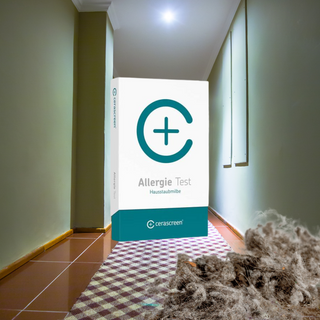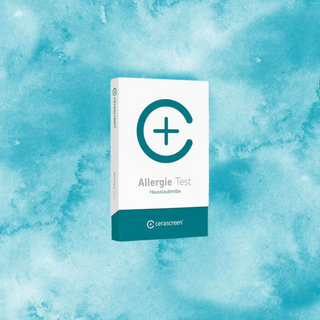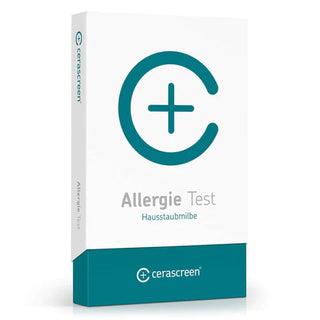-
Product description
Please note that a meaningful result can only be obtained if you have previously (approx. 2 weeks) come into contact with the allergen.
House dust allergies are caused by house dust mites, which are microscopic arachnids and occur naturally in the living environment. They feed on dead human skin, mold and components of down feathers - which is why you can find them in particularly large numbers in the bed. They also like humidity and warmth.
The animals themselves are harmless, they cannot sting or bite and do not transmit diseases. They are also not a sign of poor hygiene. However, the trigger of the allergy is not the mite itself, but its faeces, its eggs or the remains of the mite. These mix with house dust when you shake out the bed, for example, and are then inhaled. 1 g of house dust can contain 500-10,000 mites with a size of about 0.3 mm. When inhaled, the allergen can activate the immune system in some people, leading to the formation of antibodies, the IgE, which are supposed to fight these foreign substances.
The part of the substance that triggers the reaction is called the allergen. These are mostly proteins.
So-called cross-reactions, in which the immune system also reacts to species-similar allergens, can also lead to symptoms when eating shellfish if you have a house dust mite allergy. It is then spoken of the mite-shellfish syndrome.Your personal test results
Click once, know everything: In your online customer area we present you with the evaluation of your cerascreen tests - of course password-protected for maximum security! And in your individual expert report you will find out which substances have a negative effect on your performance and thus limit you in everyday life.

This is how the test works



1. Blood collection
With the help of our test kit, you take a small blood sample from your fingertip and send it to our laboratory free of charge in the enclosed envelope.2. Evaluation
In the laboratory, your blood sample will be examined using an extensive analysis.3. Detailed result report
After a few days, you can view your result report online in your secure "My cerascreen" area.
Laboratory with certified quality management system

cerascreen® GmbH is a subsidiary of DST Diagnostische Systeme & Technologie GmbH, which has been specializing in holistic diagnostics for over 10 years. The cerascreen concept is based on many years of experience in DST human diagnostics and the competence and advice of experienced health experts.
Certifications:
- TÜV Rheinland according to DIN EN ISO 13485
- EC declarations of conformity & round robin test
The test kit consists of:
-
- a multi-page, illustrated manual, which explains step by step the blood collection and the test procedure
- 2 return cards with test ID for registration
- Disinfection wipe, swab, plaster, 2 lancets CE 0344, blood collection tube, transport tube
- name label
- a return bag with which you can send your blood sample back to our laboratory by post free of charge

Procedure for the cerascreen house dust allergy test
Using the equipment contained in the house dust allergy test kit, you can take a small blood sample from your fingertip at home, following the enclosed instructions. This will be sent back to the cerascreen laboratory free of charge in the envelope provided. A complex analysis of your blood then takes place in the laboratory. The results of the house dust allergy test will then be made available to you after a few days on the secure online portal "My cerascreen".
What is a house dust allergy
The cerascreen house dust allergy test detects whether your blood contains IgE antibodies against the most common house mites in Europe. However, a possible allergic reaction is not triggered by the mites themselves, but by the allergens in their excretions. Intolerance to these allergens is detected using a house dust allergy test. About a tenth of the German population is allergic to mite droppings, which surround us as a normal part of house dust. Therefore, the allergy is simply referred to as house dust allergy. The excretions of the house mites get into the house dust by drying out and breaking up into many small particles. These particles are mixed with the house dust and spread throughout the house. They are mainly found in the textiles of every household, such as bed covers or pillows. When these are stirred up or moved, the dust and allergens they contain rise up and are inhaled as part of the air we breathe. Most of the symptoms that often prompt sufferers to carry out a house dust allergy test occur between May and October. During this period, the mites multiply the most and a large number of them die at the beginning of this hot period due to the falling relative humidity in the home. If you feel that you need a house dust allergy test, you don't have to be ashamed. The presence of the responsible mites is not caused by poor hygiene. This is because the mites are attracted to the dead skin cells that are usually found in the dust and that serve as food for you.
How do you recognize a house dust allergy?
The symptoms that often motivate those affected to undergo a house dust allergy test are very similar to those of colds or hay fever. A house dust allergy manifests itself primarily in:
- itchy or watery eyes
- Headache
- Sore throat
- coughing
- sneezing or a stuffy nose
- skin irritation
- shortness of breath and allergic asthma
Anyone who experiences several of these symptoms should urgently carry out a house dust allergy test to confirm the diagnosis. Since both the intensity and the duration of contact with the allergens play a role, individuals with a house dust allergy suffer primarily in the morning hours after getting up and during the night. This affects the sleep quality of those affected, whose tiredness should be another incentive to carry out a house dust allergy test.
Treatment of house dust allergy
Once a house dust allergy test has confirmed an allergy to house dust mite excretions, the available treatments can be considered. Here, on the one hand, permanent treatment of the allergy and, on the other hand, a short-term fight against the symptoms are possible.
Long-term treatment of house dust allergy
Anyone who has received a positive result in a house dust allergy test should do everything possible to alleviate their house dust allergy in the long term. For this purpose, a so-called allergy vaccination or hyposensitization is used, which slowly familiarizes the body with the allergy-causing substances. To achieve this goal, the affected patient is given doses of the allergen, be it in the form of tablets, an injection or drops. This trains the immune system and reduces the physical reaction to subsequent exposure to the allergen. Successful desensitization not only combats the symptoms, but also eliminates the actual cause of the allergy. However, this can take a very long time (up to five years), which is why, if the house dust allergy test is positive, it is advisable to combat the symptoms in the short term in order to improve the quality of life of the sufferer.
Short-term treatment of house dust allergy symptoms
If a house dust allergy test has identified a corresponding allergy, short-term drug therapy is usual to alleviate the symptoms of those affected. For this purpose, common antiallergic drugs are used, such as antihistamines and glucocorticoid solutions. It is also helpful to reduce the allergen load in order to avoid further irritation of the organism. In contrast to a pollen allergy, with a house dust allergy it is not difficult to actively combat the presence of allergens, i.e. house mites and their excretions. If the house dust allergy test is positive, you should ventilate the room regularly and keep the room temperature and humidity in the bedroom as low as possible.
How to get your house dust allergy under control – helpful tips
Was the result of your cerascreen house dust allergy test positive? No problem! These helpful tips will help you get your house dust allergy under control:
- Avoid storing dust in your household by doing without unnecessary dust collectors and regularly cleaning all surfaces of dust with a damp cloth.
- Frequent vacuuming is another important factor in dust control.
- Since mites feel very comfortable in textiles, you should change your bed linen regularly and wash it at at least 60 degrees.
- Annual mattress cleaning is also very helpful to prevent dust mites and their excrements from accumulating in your bed.
- In addition, there are special covers for bed linen and mattresses for people who are allergic to house dust, so-called "encasings", which are impenetrable for dust mites and thus prevent them from eating.
- Unfortunately, there is bad news for animal lovers: If the result of your house dust allergy test is positive, you should refrain from keeping pets in your apartment or letting them into your bedroom.
- If textile items such as pillows are already infested with dust mites, it is helpful to place them in the freezer for 24 hours or subject them to high temperatures in the tumble dryer, as both heat and cold are deadly to dust mites.
If the result of your house dust allergy test is positive, there is no reason to despair. Now you know what is behind your symptoms and you can fight and overcome your house dust allergy in many ways. So get tested today!
Product description
Please note that a meaningful result can only be obtained if you have previously (approx. 2 weeks) come into contact with the allergen.
House dust allergies are caused by house dust mites, which are microscopic arachnids and occur naturally in the living environment. They feed on dead human skin, mold and components of down feathers - which is why you can find them in particularly large numbers in the bed. They also like humidity and warmth.
The animals themselves are harmless, they cannot sting or bite and do not transmit diseases. They are also not a sign of poor hygiene. However, the trigger of the allergy is not the mite itself, but its faeces, its eggs or the remains of the mite. These mix with house dust when you shake out the bed, for example, and are then inhaled. 1 g of house dust can contain 500-10,000 mites with a size of about 0.3 mm. When inhaled, the allergen can activate the immune system in some people, leading to the formation of antibodies, the IgE, which are supposed to fight these foreign substances.
The part of the substance that triggers the reaction is called the allergen. These are mostly proteins.
So-called cross-reactions, in which the immune system also reacts to species-similar allergens, can also lead to symptoms when eating shellfish if you have a house dust mite allergy. It is then spoken of the mite-shellfish syndrome.
Your personal test results
Click once, know everything: In your online customer area we present you with the evaluation of your cerascreen tests - of course password-protected for maximum security! And in your individual expert report you will find out which substances have a negative effect on your performance and thus limit you in everyday life.

This is how the test works

|
 |
 |
|
1. Blood collection With the help of our test kit, you take a small blood sample from your fingertip and send it to our laboratory free of charge in the enclosed envelope. |
2. Evaluation In the laboratory, your blood sample will be examined using an extensive analysis. |
3. Detailed result report After a few days, you can view your result report online in your secure "My cerascreen" area. |
Laboratory with certified quality management system

cerascreen® GmbH is a subsidiary of DST Diagnostische Systeme & Technologie GmbH, which has been specializing in holistic diagnostics for over 10 years. The cerascreen concept is based on many years of experience in DST human diagnostics and the competence and advice of experienced health experts.
Certifications:
- TÜV Rheinland according to DIN EN ISO 13485
- EC declarations of conformity & round robin test
The test kit consists of:
-
- a multi-page, illustrated manual, which explains step by step the blood collection and the test procedure
- 2 return cards with test ID for registration
- Disinfection wipe, swab, plaster, 2 lancets CE 0344, blood collection tube, transport tube
- name label
- a return bag with which you can send your blood sample back to our laboratory by post free of charge

Procedure for the cerascreen house dust allergy test
Using the equipment contained in the house dust allergy test kit, you can take a small blood sample from your fingertip at home, following the enclosed instructions. This will be sent back to the cerascreen laboratory free of charge in the envelope provided. A complex analysis of your blood then takes place in the laboratory. The results of the house dust allergy test will then be made available to you after a few days on the secure online portal "My cerascreen".
What is a house dust allergy
The cerascreen house dust allergy test detects whether your blood contains IgE antibodies against the most common house mites in Europe. However, a possible allergic reaction is not triggered by the mites themselves, but by the allergens in their excretions. Intolerance to these allergens is detected using a house dust allergy test. About a tenth of the German population is allergic to mite droppings, which surround us as a normal part of house dust. Therefore, the allergy is simply referred to as house dust allergy. The excretions of the house mites get into the house dust by drying out and breaking up into many small particles. These particles are mixed with the house dust and spread throughout the house. They are mainly found in the textiles of every household, such as bed covers or pillows. When these are stirred up or moved, the dust and allergens they contain rise up and are inhaled as part of the air we breathe. Most of the symptoms that often prompt sufferers to carry out a house dust allergy test occur between May and October. During this period, the mites multiply the most and a large number of them die at the beginning of this hot period due to the falling relative humidity in the home. If you feel that you need a house dust allergy test, you don't have to be ashamed. The presence of the responsible mites is not caused by poor hygiene. This is because the mites are attracted to the dead skin cells that are usually found in the dust and that serve as food for you.
How do you recognize a house dust allergy?
The symptoms that often motivate those affected to undergo a house dust allergy test are very similar to those of colds or hay fever. A house dust allergy manifests itself primarily in:
- itchy or watery eyes
- Headache
- Sore throat
- coughing
- sneezing or a stuffy nose
- skin irritation
- shortness of breath and allergic asthma
Anyone who experiences several of these symptoms should urgently carry out a house dust allergy test to confirm the diagnosis. Since both the intensity and the duration of contact with the allergens play a role, individuals with a house dust allergy suffer primarily in the morning hours after getting up and during the night. This affects the sleep quality of those affected, whose tiredness should be another incentive to carry out a house dust allergy test.
Treatment of house dust allergy
Once a house dust allergy test has confirmed an allergy to house dust mite excretions, the available treatments can be considered. Here, on the one hand, permanent treatment of the allergy and, on the other hand, a short-term fight against the symptoms are possible.
Long-term treatment of house dust allergy
Anyone who has received a positive result in a house dust allergy test should do everything possible to alleviate their house dust allergy in the long term. For this purpose, a so-called allergy vaccination or hyposensitization is used, which slowly familiarizes the body with the allergy-causing substances. To achieve this goal, the affected patient is given doses of the allergen, be it in the form of tablets, an injection or drops. This trains the immune system and reduces the physical reaction to subsequent exposure to the allergen. Successful desensitization not only combats the symptoms, but also eliminates the actual cause of the allergy. However, this can take a very long time (up to five years), which is why, if the house dust allergy test is positive, it is advisable to combat the symptoms in the short term in order to improve the quality of life of the sufferer.
Short-term treatment of house dust allergy symptoms
If a house dust allergy test has identified a corresponding allergy, short-term drug therapy is usual to alleviate the symptoms of those affected. For this purpose, common antiallergic drugs are used, such as antihistamines and glucocorticoid solutions. It is also helpful to reduce the allergen load in order to avoid further irritation of the organism. In contrast to a pollen allergy, with a house dust allergy it is not difficult to actively combat the presence of allergens, i.e. house mites and their excretions. If the house dust allergy test is positive, you should ventilate the room regularly and keep the room temperature and humidity in the bedroom as low as possible.
How to get your house dust allergy under control – helpful tips
Was the result of your cerascreen house dust allergy test positive? No problem! These helpful tips will help you get your house dust allergy under control:
- Avoid storing dust in your household by doing without unnecessary dust collectors and regularly cleaning all surfaces of dust with a damp cloth.
- Frequent vacuuming is another important factor in dust control.
- Since mites feel very comfortable in textiles, you should change your bed linen regularly and wash it at at least 60 degrees.
- Annual mattress cleaning is also very helpful to prevent dust mites and their excrements from accumulating in your bed.
- In addition, there are special covers for bed linen and mattresses for people who are allergic to house dust, so-called "encasings", which are impenetrable for dust mites and thus prevent them from eating.
- Unfortunately, there is bad news for animal lovers: If the result of your house dust allergy test is positive, you should refrain from keeping pets in your apartment or letting them into your bedroom.
- If textile items such as pillows are already infested with dust mites, it is helpful to place them in the freezer for 24 hours or subject them to high temperatures in the tumble dryer, as both heat and cold are deadly to dust mites.
If the result of your house dust allergy test is positive, there is no reason to despair. Now you know what is behind your symptoms and you can fight and overcome your house dust allergy in many ways. So get tested today!













